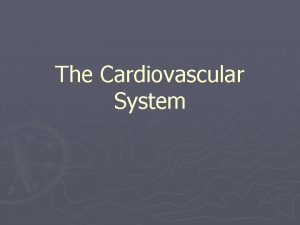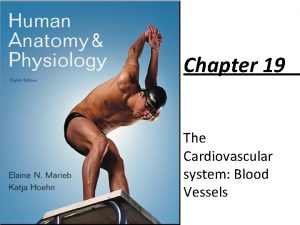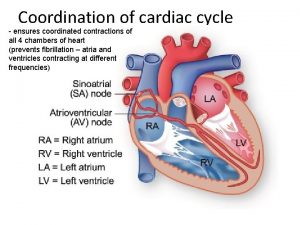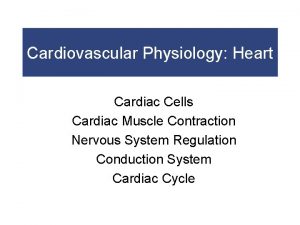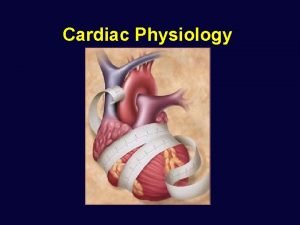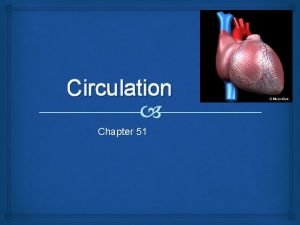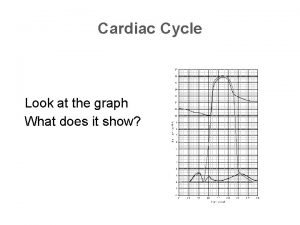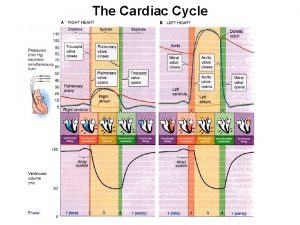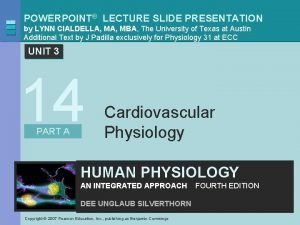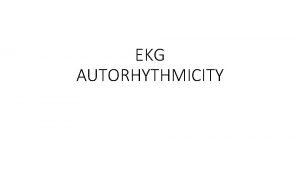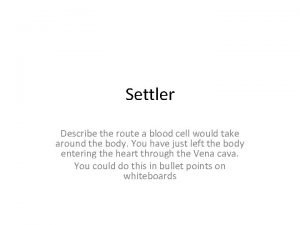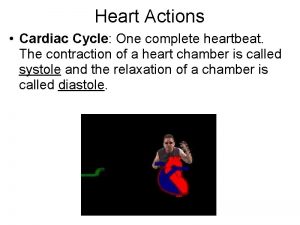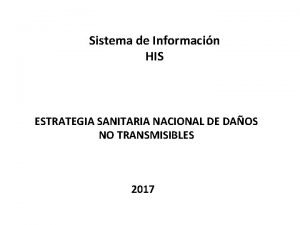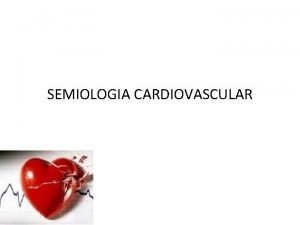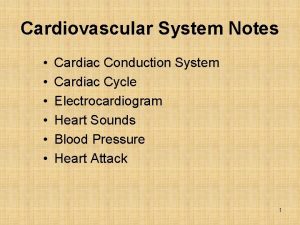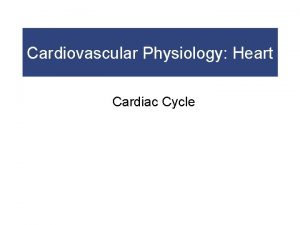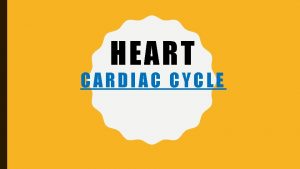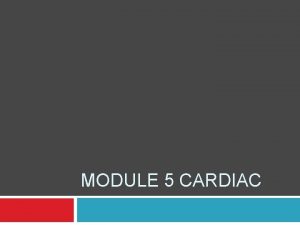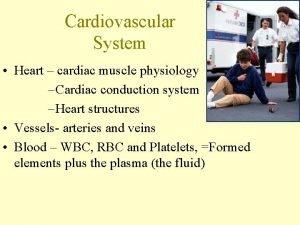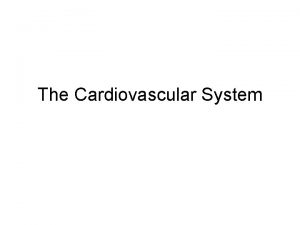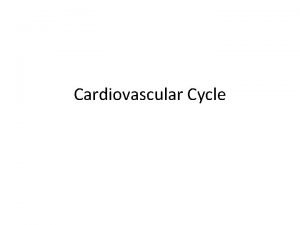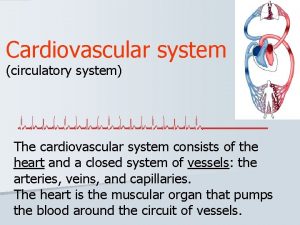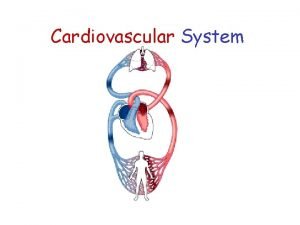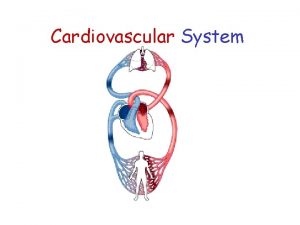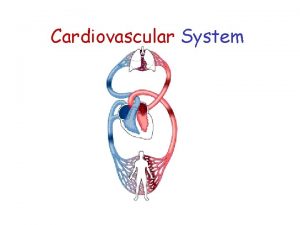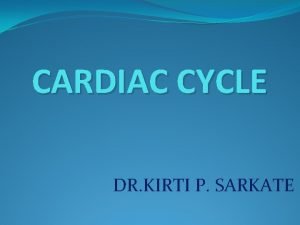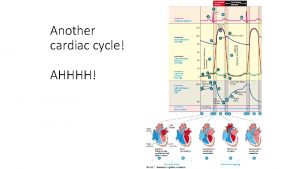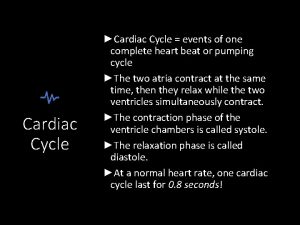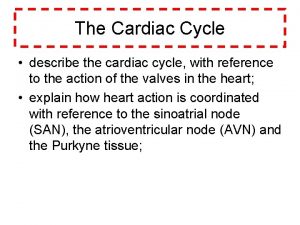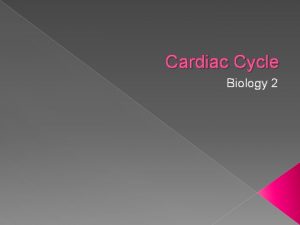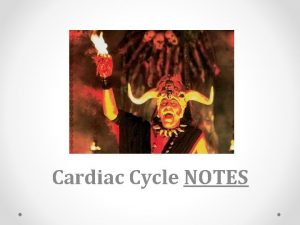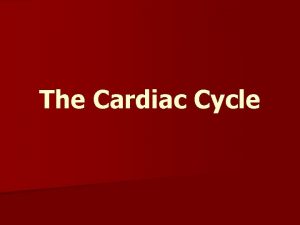Cardiovascular System Esraa kiwan Cardiac Cycle Cardiac cycle



































- Slides: 35

Cardiovascular System Esraa kiwan

Cardiac Cycle Cardiac cycle (at rest) 800 msec Diastole Systole 500 msec 300 msec

Blood normally flows in a laminar fashion (layer of fluid slide smoothly over each other, doesn't produce sound When blood flow become turbulent, a sound is produced, due to vibrations created in the surrounding structures

Cardiac Output: is the volume of blood pumped by each ventricle per minute

Cardiac Output Cardiac output = Stroke Volume X Heart Rate CO = SV x HR Stroke Volume: volume of blood pumped by each ventricle per beat or stroke (averages 70 ml/beat) Heart Rate: heart beats/min (averages 70 beats/min)

Cardiac Output Stroke Volume: volume of blood pumped per beat or stroke (averages 70 ml/beat) Heart Rate: heart beats/min (averages 70 beats/min) CO = SV x HR CO= 70 ml/beat x 70 beats/min = 4, 900 ml/min ≈ 5 liters/min

Cardiac Output Resting cardiac output ≈ 5 L/min During exercise cardiac output can increase to 20 to 25 L/min Cardiac reserve: the difference between the cardiac output at rest and the maximum volume of blood the heart can pump per minute

Cardiac Output Cardiac output depends on heart rate and the stroke volume CO = SV x HR ( cardiac output increases or decreases in response to changes in heart rate or stroke volume. i. e. when one of them increase it will increase the cardiac out put)

The heart is innervated by both divisions of the autonomic nervous system (sympathetic & parasympathetic), which can modify the rate & strength of contraction. (not initiation of contraction)

Autonomic Regulation of HR


Stroke Volume Control Two types of controls influences stroke volume: Extrinsic control Intrinsic control The extent of venous return The extent of sympathetic stimulation of the heart Both factors increase stroke volume by increasing the strength of contraction of the heart

Stroke Volume Control Intrinsic control: Intrinsic ability to regulate SV (output) in response to changes in venous return (input)



Stroke Volume Control

Stroke Volume Control Extrinsic control: (sympathetic nervous system) Arterial muscle: increases contractility Ventricular muscle: increases contractility Adrenal medulla: increase epinephrine (augments the sympathetic actions on the heart) Veins: increase venous return

Effect Of Sympathetic Stimulation On SV

Shift of the frank starling curve to the left by sympathetic stimulation

Cardiac Output Regulation

Blood Pressure Blood pressure is the force exerted by the blood against a vessel wall Depends on: Volume of blood contained within the vessel Compliance or Distensability of the vessel wall

Blood Pressure During each heartbeat, Blood pressure varies between a maximum (systolic) and a minimum (diastolic) pressure Systolic pressure: The maximum pressure exerted in the arteries when the blood is ejected into them during ventricular systole averages 120 mm. Hg Diastolic pressure: The minimum pressure within the arteries occurs when the blood is draining off into the rest of vessels during ventricular diastole averages 80 mm. Hg

Blood Pressure Measurement Directly: inserting a needle (a canula) to blood vessel, which is linked to a device measure the blood pressure Indirectly: through the use of a sphygmomanometer

Blood Pressure Measurement


Blood Pressure Pulse pressure: is the difference between systolic and diastolic pressure (systolic – diastolic) Blood pressure = 120/80 Pulse pressure 40 mm. Hg Mean arterial pressure: is the average pressure responsible for driving blood forward MAP= diastolic pressure + 1/3 pulse pressure = 80 + (1/3 * 40) = 93 mm. Hg

Regulation of blood pressure Blood pressure is regulated by controlling: Cardiac output Total peripheral resistance Blood volume Blood pressure= cardiac output X peripheral resistance Cardiac output= HR X SV Total peripheral resistance depends on the radius of all arterioles as well as blood viscosity Resistance 1/r� ( r: radius of the vessel)

Regulation of Blood Pressure Cardiac output= HR X SV HR SV


Regulation Of Blood Pressure Total peripheral resistance:

Regulation of Blood Pressure

Regulation of Blood Pressure Baroreceptor:

Regulation of Blood Pressure Baroreceptor:

Regulation of Blood Pressure Baroreceptor:

Regulation of Blood Pressure Blood volume:
 Hemerriod
Hemerriod The circulatory or cardiovascular system chapter 19
The circulatory or cardiovascular system chapter 19 What makes up the circulatory system
What makes up the circulatory system Pithed model
Pithed model Cardiovascular/lymphatic system it's totally tubular
Cardiovascular/lymphatic system it's totally tubular Coronary circulation of heart
Coronary circulation of heart Cengage chapter 5
Cengage chapter 5 Chapter 11 the cardiovascular system figure 11-3
Chapter 11 the cardiovascular system figure 11-3 Figure 11-12 is a diagram of a capillary bed
Figure 11-12 is a diagram of a capillary bed Chapter 11 the cardiovascular system
Chapter 11 the cardiovascular system Lesson 11 cardiovascular system
Lesson 11 cardiovascular system Circulatory system tissue
Circulatory system tissue Anatomy blood vessels
Anatomy blood vessels Introduction to cardiovascular system
Introduction to cardiovascular system Stent placement
Stent placement Anatomy and physiology unit 7 cardiovascular system
Anatomy and physiology unit 7 cardiovascular system Cardiovascular system diseases and disorders chapter 8
Cardiovascular system diseases and disorders chapter 8 Chapter 13 cardiovascular system
Chapter 13 cardiovascular system Chapter 11 the cardiovascular system figure 11-2
Chapter 11 the cardiovascular system figure 11-2 The cardiovascular system includes the
The cardiovascular system includes the Chapter 19 cardiovascular system blood
Chapter 19 cardiovascular system blood True capillaries
True capillaries Cardiac cycle steps
Cardiac cycle steps Cardiac cycle
Cardiac cycle Events of cardiac cycle class 11
Events of cardiac cycle class 11 Intrinsic conduction system
Intrinsic conduction system Cardiac output animation
Cardiac output animation Cardiac cycle graph
Cardiac cycle graph Urutan sistole
Urutan sistole Cardiac cycle
Cardiac cycle Figure 20-2 cardiac cycle
Figure 20-2 cardiac cycle Cardiac cycle
Cardiac cycle Purkyne tissue
Purkyne tissue One complete heartbeat
One complete heartbeat Riesgo cardiovascular por perimetro abdominal
Riesgo cardiovascular por perimetro abdominal Maniobra de pachon
Maniobra de pachon



















